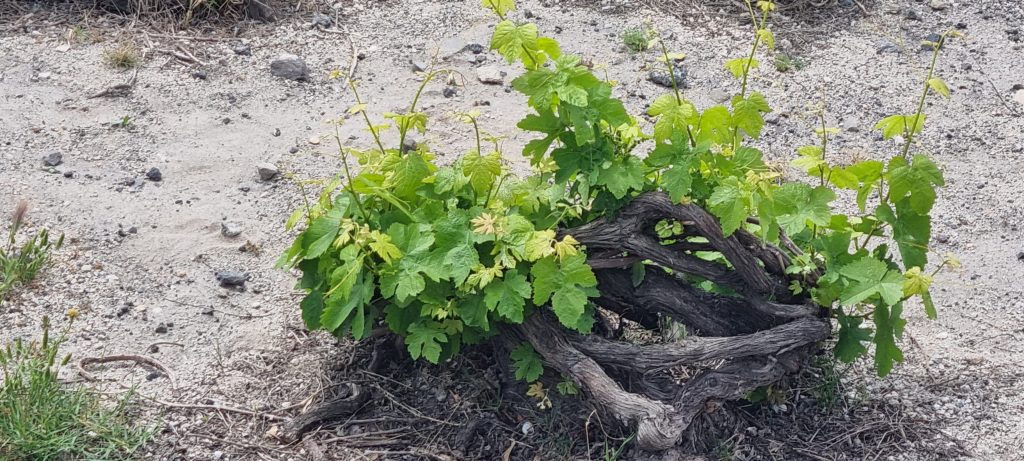Written by Norrelle Goldring
On a recent trip to Greece, I found myself on Santorini, famous for its stunning sunsets, volcanic soils, and unique wines, particularly Assyrtiko. This is a crisp, mineral-driven white wine perfectly suited to the island’s harsh, dry conditions.
Locally, you may have tried Jim Barry’s take on it. I subsequently wound up on an ‘Assyrtiko tour’ of Greece for a month, sampling the variety from numerous regions and in blends with Sauvignon Blanc (apparently partly the impact of flying winemakers) and Malagousia.
What also fascinated me on Santorini was the traditional viticultural practice of coiling vines into basket or wreath shapes close to the ground. This method, known locally as ‘kouloura’, is designed to trap humidity and protect grapes from intense sunlight and wind. Obviously, it makes for hand-harvesting so is not a method suitable for large scale vineyards, but nevertheless, is indicative of adopting practices to suit harsh climate conditions.

Shortly after arriving back home, I visited Lowe Wines in Mudgee, New South Wales. There, the winemaker passionately discussed how he’s exploring leaning into Mediterranean grape varieties from Italy and Greece – varietals naturally suited to hotter, drier climates – as proactive measures against predicted temperature and drought increases.
Climate change presents multiple threats to Australian winemaking. Increased temperatures accelerate ripening, impacting grape acidity and sugar balance, and ultimately altering wine style and quality. Reduced rainfall and frequent drought conditions strain water resources, making traditional varieties like Shiraz, Cabernet Sauvignon, and Chardonnay harder to sustain in historically dependable regions like Barossa, Hunter Valley, or Margaret River. It’s evident that Australian wineries must either adapt swiftly or risk facing severe production challenges.
One practical adaptation is varietal diversification. Mediterranean and Greek grape varieties naturally possess traits ideal for Australia’s evolving climate. Assyrtiko, my newfound favourite, is a compelling example. This variety maintains impressive acidity and minerality even under intense heat and minimal rainfall. Its adoption across warmer Australian regions – such as McLaren Vale, Barossa, and Mudgee – offers promise, given its proven resilience and commercial appeal.
Other Greek grapes, such as Malagousia, Roditis, Agiorgitiko, and Xinomavro, also offer intriguing potential. Malagousia delivers aromatic complexity and freshness despite heat stress. Roditis adapts well to dry conditions, producing fresh, citrus-driven wines. Agiorgitiko, a versatile red from the Peloponnese, delivers structured yet fruity wines in hot climates. Xinomavro, known for its structured, age-worthy qualities, thrives in conditions similar to Australia’s inland heat.
Beyond simply switching grape varieties, Australian wineries are also reconsidering viticultural practices. The basket trellising I witnessed in Santorini exemplifies innovative adaptation. The principle behind it, that of creating microclimates to manage heat stress and retain humidity, offers inspiration. Vineyards can adopt canopy management techniques like vertical shoot positioning, shading, and strategic pruning to minimise heat exposure, regulate vine vigour, and preserve fruit integrity under intense sun and heat.
Soil and water management adaptations are equally crucial. Practices like mulching, planting drought-resistant cover crops, and improved drip irrigation techniques are becoming widespread. These strategies not only enhance water retention but also improve vine health and grape quality.
The viticultural shifts necessitated by climate change also demand consumer education. Australian wine drinkers have long cherished Shiraz, yet new varietals such as Assyrtiko remain unfamiliar territory. Wineries, retailers, and hospitality venues must work collectively to introduce new varieties, guiding consumers toward understanding and appreciating wines adapted to Australia’s new climate reality. My own Greek wine discoveries underscore the potential for these varieties to gain popularity through informed tasting experiences and storytelling. And Australian consumers have certainly embraced varieties such as Tempranillo with gusto.
Regional considerations also come into play. Cooler climate regions like Tasmania and the Adelaide Hills may currently have some latitude to persist with traditional grape varieties longer, albeit with adjustments like higher-altitude planting or protective vineyard management practices. Conversely, regions such as the Riverland, Sunraysia, and inland NSW will likely face more rapid and significant varietal transitions, making Mediterranean grapes particularly attractive options there.
My recent experiences in Greece and Mudgee have illuminated, for me at least, a clear pathway for the future of Australian wine: embracing resilient grape varieties, innovating vineyard management techniques, and proactively responding to climate pressures. By learning from traditional Mediterranean practices and thoughtfully integrating them with Australia’s own viticultural heritage, we can ensure a thriving, sustainable future for Australia’s wine industry amid climate uncertainty.
This article originally appeared in the August-September issue of National Liquor News.

